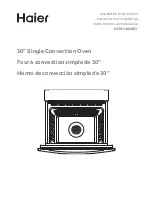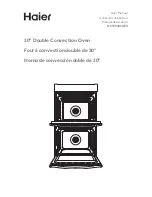
31
Tables and tips
en
J
Tables and tips
Tables and tips
Notes
–
Always preheat the appliance.
This will produce the best cooking results. The
cooking times specified refer to a preheated
appliance.
–
The values specified are intended as a guide. The
actual cooking time depends on the quality and
temperature of the food before cooking, as well as
its weight and thickness.
–
The tables list temperature and/or time ranges. Try
the lowest value to start with. You can always
choose a longer time next time, if required.
A lower temperature results in more even browning.
If necessary, set a higher temperature.
–
The figures listed refer to average quantities of food
for four people. If you wish to cook a larger quantity
of food, you should allow for extra cooking time.
–
Use the cookware specified. If you use other
cookware, the cooking times may be longer or
shorter.
–
You can use any heat-resistant cookware. Place the
cookware in the centre of the wire rack. For large
roasts, you can also use the grill tray or glass dish.
–
Do not place too many items close together on wire
racks or baking trays. This is the only way to ensure
optimal heat circulation.
–
To prepare bulky food items, you can remove the
shelf supports at both sides. Place the wire rack
directly onto the bottom of the cooking
compartment and place the food or roasting dish
onto the wire rack. Do not place the food or
roasting dish directly onto the enamel bottom of the
cooking compartment.
–
Open the door of the preheated oven for a short
time only when placing food inside the cooking
compartment.
–
The figures given for the level refer to the rack level
(counting from the bottom) in appliances with
four rack levels. The figures in brackets refer to
appliances with five rack levels.
–
Once you have taken glass cookware out of the
oven, set it down on a dry trivet or heat-proof mat;
never set it down on a cold or wet surface.
Otherwise, the glass may crack.
–
Some operating modes are not available on all oven
models or are only available in conjunction with
certain optional accessories.
–
Eco hot air:
Energy-saving hot air mode for cakes, meat, bakes
and gratins. Optimal use is made of the residual
heat. Convenience functions remain switched off
(e.g. the interior lighting). The interior temperature
can only be displayed while the appliance is heating
up. Do not preheat the oven.
Make sure that the cooking compartment is cold
and that there is nothing already in there when you
place the food inside. Then start the specified
cooking time. Always keep the appliance door
closed when cooking. This prevents heat loss.
–
Full surface grill and full surface grill +
circulated air:
With these operating modes, there may be a
temperature difference between the temperature
you have set and the actual temperature inside the
oven. This is because grilling and browning are fast
cooking processes that require high temperatures.
Consequently, for browning and roasting, a higher
temperature than is actually needed on the surface
of the food is selected.
Vegetables
▯
Oven-roasted or oven-baked vegetables are a good
alternative to pan-fried vegetables. The different
flavours become more concentrated and, because
the vegetables are roasted, they have a very
distinctive taste. In addition, very little fat is
required to prepare the vegetables.
▯
Clean and prepare the vegetables and mix them
with a little oil in a bowl. Place them in a heat-
resistant baking dish or tin or in the glass dish/grill
tray and spread them out evenly.
▯
Mix them thoroughly at least once during the
cooking process. Once they are cooked, season
them and sprinkle them with fresh herbs to taste.
▯
Vegetables are good as a hot or cold starter or
vegetarian main course, or as an accompaniment to
meat and fish.
▯
Use an ovenproof dish for small portions (for 2 - 3
people) and place it on the wire rack. If you use the
glass dish/grill tray, the food will start to burn or dry
out.
▯
In addition, always follow the manufacturer's
instructions for pre-cooked and frozen products.
















































